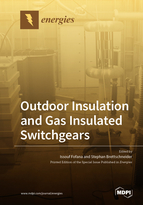Outdoor Insulation and Gas Insulated Switchgears
A special issue of Energies (ISSN 1996-1073). This special issue belongs to the section "F: Electrical Engineering".
Deadline for manuscript submissions: closed (15 September 2021) | Viewed by 31265
Special Issue Editors
Interests: Electromagnetic compatibility; Electrical engineering; Electrical insulation; Dielectric materials; Problems associated with the transport and distribution of electrical energy
Special Issues, Collections and Topics in MDPI journals
Interests: power system protection; power network analysis; HV testing techniques; diagnostic and monitoring
Special Issues, Collections and Topics in MDPI journals
Special Issue Information
Dear Colleagues,
With the growth of the world’s population and faster-developing industries, larger amounts of electric energy are needed. To reduce Joule losses at longer distances, higher transmission voltages are required. Many ultra/extra AC/DC high-voltage transmission projects have been commissioned or are under construction in many countries: Canada (735 kV), Venezuela (800 kV), China (1100 kV), Japan (1100 kV), and India (1200 kV). Understanding the fundamental aspects of outdoor insulation is, therefore, important for properly designing practical HV transmission lines and hardware.
The Special Issue will cover theoretical and practical developments with special emphasis on engineering problems in designing and monitoring of AC/DC high-voltage transmission lines and solutions to mitigate atmospheric conditions influence. The applications of new materials in the novel design of transmission line hardware and perspectives are also concerned.
Topics of interest for special issue include, but are not limited to:
- Lightning phenomena and related applications
- Long air gap discharges
- Switching surges
- Insulation coordination
- Breakdown and pre-breakdown phenomena in gases
- Insulating material efficiency improvement by chemical admixtures
- Gas insulated switchgears (GIS)
- Measurement, monitoring and diagnostic techniques
Manuscript Submission Information
Manuscripts should be submitted online at www.mdpi.com by registering and logging in to this website. Once you are registered, click here to go to the submission form. Manuscripts can be submitted until the deadline. All submissions that pass pre-check are peer-reviewed. Accepted papers will be published continuously in the journal (as soon as accepted) and will be listed together on the special issue website. Research articles, review articles as well as short communications are invited. For planned papers, a title and short abstract (about 100 words) can be sent to the Editorial Office for announcement on this website.
Submitted manuscripts should not have been published previously, nor be under consideration for publication elsewhere (except conference proceedings papers). All manuscripts are thoroughly refereed through a single-blind peer-review process. A guide for authors and other relevant information for submission of manuscripts is available on the Instructions for Authors page. Energies is an international peer-reviewed open access semimonthly journal published by MDPI.
Please visit the Instructions for Authors page before submitting a manuscript. The Article Processing Charge (APC) for publication in this open access journal is 2600 CHF (Swiss Francs). Submitted papers should be well formatted and use good English. Authors may use MDPI's English editing service prior to publication or during author revisions.
Keywords
- Outdoor insulators
- Atmospheric icing and pollution-related phenomena
- Lightning physics and protection
- Discharges in air and gases
- Insulation coordination







